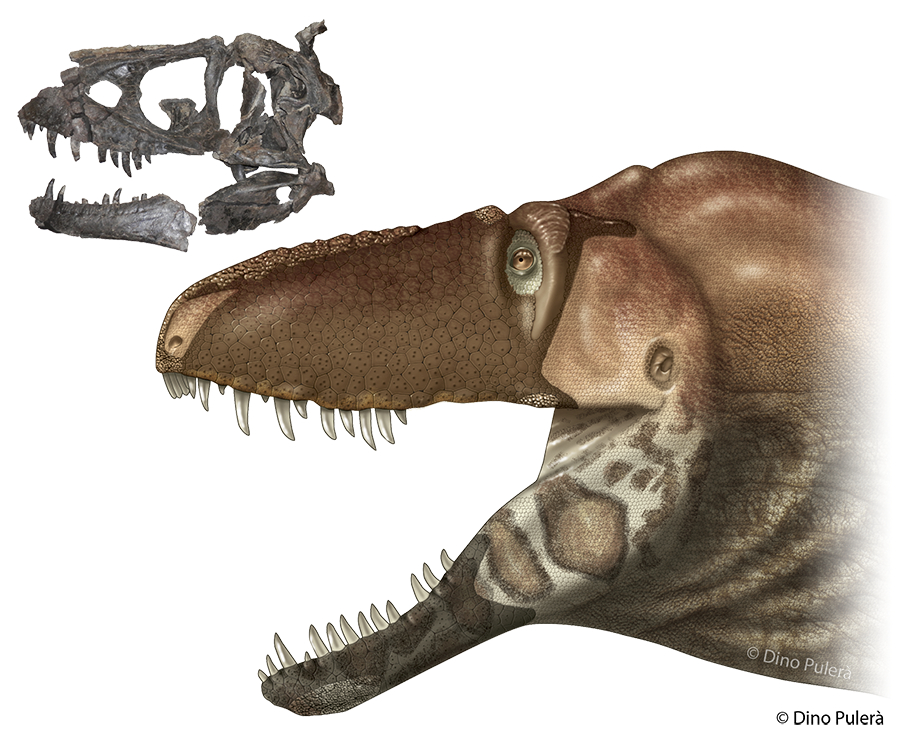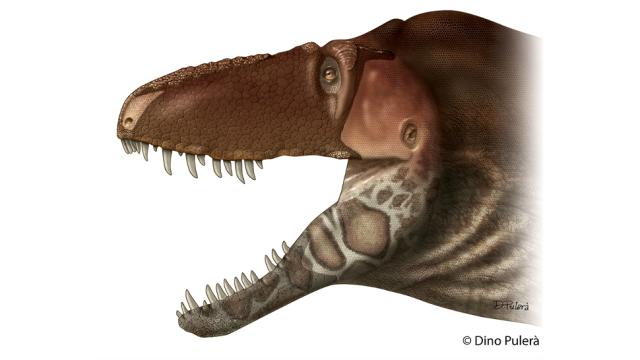A newly-discovered tyrannosaur that lived 75 million years ago in what is now Montana is offering insights into the facial features and uncanny senses of these fearsome prehistoric beasts. Like modern crocodiles, tyrannosaurs had faces covered with highly sensitive scales that allowed them to sense the slightest changes to their environment — like their next meal trying to avoid detection.
As if tyrannosaurs weren’t formidable and frightening enough, new research published in Scientific Reports shows the surprising degree to which these two-legged predators used hypersensitive snouts to locate prey, protect their young, identify objects, and interact with one another. These findings were made possible by the discovery exquisitely-preserved fossils of a new species of tyrannosaur, Daspletosaurus horneri, and an emerging palaeontological technique in which prehistoric fossils are compared to the bones of modern animals. Comparative analysis between these new tyrannosaur fossils and other specimens suggests all tyrannosaurs were equipped with a “sixth sense” that’s virtually identical to one utilised by living crocodiles. It’s a potent example of convergent evolution at work.
The first fossilised remains of D. horneri were uncovered in 1992, but the new study, led by Carthage College palaeontologist Thomas Carr, finally names the species, and places the animal firmly within the tyrannosaur family of dinosaurs, a group that includes well over a dozen species that lived during the Late Cretaceous period some 66 to 94 million years ago. Daspletosaurus horneri is named in honour of palaeontologist Jack Horner, and it literally translates to “Horner’s Frightful Lizard”.
Similar to its tyrannosaurid cousins, including Appalachiosaurus, Albertosaurus, Daspletosaurus and the famous Tyrannosaurus rex, this fearsome apex predator featured a massive skull balanced by an enormous, heavy tail. D. horneri was approximately 2.2m tall and 9m long. As the new research shows, it had small patches of armour-like skin and horns, a highly sensitive snout, and a face covered in large, flat scales.

Importantly, the researchers say that the hypersensitive snout is a feature common to all tyrannosaurs; the new study is the first to identify the “sixth sense” in D. horneri, but the features responsible for the characteristic are found in all tyrannosaurs. Back in 2009, palaeontologists described the facial characteristics of horned dinosaurs (ceratopsids), but this marks the first time that researchers have managed to reconstruct and identify the finer facial details of a tyrannosaur.
To do so, the researchers analysed a set of exquisitely-preserved fossils found in present day Montana, including skulls, jaws and various bones of both adults and juveniles. By comparing these fossils to modern crocodiles, birds and mammals, along with earlier studies that matched bone texture with various skin coverings of living animals, the researchers were able to infer the presence and location of arteries and nerves. Of particular importance, the researchers identified the presence of a trigeminal nerve — an important sensory nerve of the face and jaws in many animals, not just tyrannosaurs.
In other animals, the trigeminal nerve has evolved to enable wildly different “sixth senses”, such as the sensing of magnetic fields among birds, electroreception in the platypus bill, the sensitivity of cat whiskers and elephant tusks, and the ability of alligators to sense vibrations through water. In tyrannosaurs, these nerves were embedded in their facial scales, turning their snouts into a kind of radar dish.
“[The] trigeminal is evolutionarily important and worthy of intense scientific attention,” Carr said. “The public does not often consider individual nerves or organ systems as having their own evolutionary history, but our research put attention on the bigger picture of the evolution of the trigeminal nerve and how is is pivotal in providing insight into how archosaurs [a family of animals that includes both crocodylians and dinosaurs] navigated and interacted with the world and each other.”
Crocodiles and dinosaurs diverged from a common ancestor around 230 million years ago. Comparing the sensorial function of a crocodile with a tyrannosaur may seem like a bit of a stretch, given their physical differences and distance on the evolutionary tree, but Carr says their facial anatomy is virtually identical from a functional perspective.
In terms how of D. horneri took advantage of its sixth sense, Carr believes the behaviour of modern-day crocodiles can offer clues.
“Crocs use their hypersensitive snouts in predation (detecting water ripples), social behaviour (snout-to-snout rubbing), assessing nest temperature (arguably the most important in terms of long-term survival of a species), and safely carrying hatchlings,” Carr told Gizmodo. “Given that the sensitive snout is so highly integrated into the day-to-day life of alligators and other crocodylians, there is every reason to suspect the same for tyrannosaurs since they were outfitted with the same equipment.”
Carr says his team’s hypothesis points the way forward for understanding the variety and evolution of dinosaur faces as a whole, including the evolution of beaks. “It is our hope that other scientists extend our type of investigation to the fossil lineages they specialise in, especially along the line to birds, the dinosaurs alive today.”
Another interesting finding of the study is that D. horneri, and all tyrannosaurs for that matter, had no lips, which only seems appropriate. Last year, University of Toronto palaeontologist Robert Reisz ruffled a few dinosaur feathers when he suggested that T-rex had lips, though he presented very little evidence to prove it. Carr says that the tyrannosaurs’ flat scales would have extended over their gums and into the tooth row, just as it does in crocodiles. “Our work,” says Carr, “rejects the lip hypothesis.”
And thank goodness for that. For the T-rex to have had both feathers and a full set of lips would have presented a truly undignified appearance for such a formidable creature.
